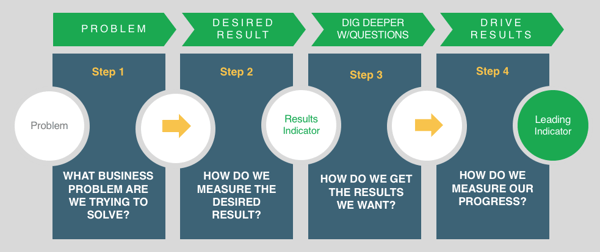When thinking about the most important numbers to measure in your business, most of our clients have  no trouble coming up with a list of results they want to achieve. The usual suspects are Revenue, Profit, EBITDA, # of customers, employees, locations, etc. These Result Indicator KPIs are essential - you need to think about the results you want to achieve in your business and set those targets. But don’t stop there! For your key performance indicators to help you solve business problems and reach your goals, you also need to develop Leading Indicator KPIs for business.
no trouble coming up with a list of results they want to achieve. The usual suspects are Revenue, Profit, EBITDA, # of customers, employees, locations, etc. These Result Indicator KPIs are essential - you need to think about the results you want to achieve in your business and set those targets. But don’t stop there! For your key performance indicators to help you solve business problems and reach your goals, you also need to develop Leading Indicator KPIs for business.
What are Leading Indicator KPIs?
Leading Indicators can help predict what will happen in the future. They let you know if you are on track to achieve your desired results. Leading Indicators are measurable, and you can influence or move them. If you determine and track Leading Indicator KPIs and make adjustments based on those indicators every week, you will have an execution advantage over your competition.
4-Step Process to Determine Leading Indicator KPIs
There’s no magic formula or standard set of Leading Indicators that works for every company. Leading Indicator KPIs only become powerful when you find the right lever to pull, impacting the most important results to your business. While we can’t tell you which leading indicators are most important in your business, we do have a proven process for determining the ones that will work for you:
Leading Indicator KPI Step 1
When determining Leading Indicator KPIs for your business, it is crucial to identify and clearly define the specific business problem you aim to solve or the opportunity you are looking to maximize. By honing in on the core issue, you can effectively align your key performance indicators with your overarching goals and objectives. This initial step sets the foundation for developing actionable insights and strategies to drive meaningful results and propel your business forward. So, take the time to pinpoint the exact challenge or potential opportunity you are focusing on, as this clarity will guide your entire KPI measurement process and pave the way for success.
Leading Indicator KPI Step 2:
When clarifying the desired result and setting success criteria on this result KPI, it is essential to make sure that it is SMART: Specific, Measurable, Achievable, Relevant, and Time-bound. By defining your goal this way, you provide a clear, actionable target that can be easily tracked and evaluated. This approach helps align your efforts with your overall objectives and allows for a more focused and effective strategy to achieve your desired results. By establishing SMART criteria for your key performance indicators, you set yourself up for success and ensure that your efforts are directed toward measurable and meaningful outcomes. We use a simple Red-Yellow-Green method.
Leading KPI Indicator Step 3:
It's crucial to delve further into the root cause of the results you want to achieve by asking the right questions. Many individuals overlook the importance of asking probing questions to uncover the underlying Leading Indicators that can drive success. By digging deeper and seeking to understand the factors that influence your desired outcomes, you can identify key metrics that directly impact your business objectives. Don't underestimate the power of thorough questioning in pinpointing the critical drivers of your performance and guiding your strategic decision-making process.
Leading KPI Indicator KPI Step 4:
To ensure that you are driving towards your desired outcomes effectively, it is imperative to establish clear success criteria and regularly monitor your Leading and Results Indicators on a dashboard. By visualizing these key performance metrics, you can easily track your progress, identify any potential issues, and make informed decisions to stay on course. Updating and reviewing this dashboard on a weekly basis allows you to remain proactive in addressing any deviations or challenges, ultimately helping you stay focused and aligned with your business goals. This consistent monitoring and evaluation process will drive results and provide valuable insights for continuous improvement and success.
Marketing Leading Indicator KPI Example
One of the most common business problems we hear about is difficulty achieving predictable results in sales and marketing. To help bring this process to life, here’s an example of how you might create a Leading Indicator KPI:
Let’s say that you are having a problem with your marketing strategy. You’re just unable to generate the number of sales-qualified leads your sales team needs to hit their quotas.- The result you are trying to impact is the number of sales-qualified leads (SQLs) the marketing team can generate monthly. When you look at the data, you can see that your sales team closes 1 out of every 10 SQLs. Their quota for the month is 50 deals closed, so the marketing team needs to provide 500 SQLs for them to hit this number. In order for your sales team to hit their numbers, Your Result KPI with Red-Yellow-Green success criteria might look like this:
- # of SQLs per month
Green: 500
Yellow: between Red and Green
Red: 400
SuperGreen (stretch goal): 600
- # of SQLs per month
- Next, we need to dig deeper with questions to understand how we can move the needle on the number of sales-qualified leads that marketing pulls in each month. Here are some of the kinds of questions you might ask:
- What makes a lead well-qualified for sales?
- Where do most of our SQLs currently come from?
- Can we do more of what we’re already doing to get more SQLs?
- What are our potential SQLs reading, or where are they going, that we can get in front of them?
- Are we offering the right content to attract SQLs to our marketing site?
- Are we promoting the content in the right places?
- Are there any trade shows or events where we can have a booth or a speaker to capture SQLs?
- What are our competitors doing to get SQLs?
Keep asking questions and digging deeper until you find something that you can measure, influence, and believe will significantly impact the result you are trying to achieve.
From our questions, most of our SQLs come from events like webinars, trade shows, and conferences. If this is how most people ready to buy find us, we might increase the number of marketing events we host or attend to capture more SQLs. Each event typically yields 50 new SQLs for us, so if we participate in 10 monthly events, we can hit our goals.
Our Leading Indicator KPI Example might look like this:
# of marketing events per month
Green: 10 events/month
Yellow: between Red & Green
Red: 5 events/month
SuperGreen: 15 events/month
We can create a dashboard where we track the events (the Leading Indicator) and the number of SQLs (the Result) to see if this is the right lever:
This example may need to be simplified, but I wanted to illustrate how the process works. The marketing team controls how many events they do to get leads, so this is measurable and movable. They can begin testing this for a quarter to see if pushing on this lever generates the number of leads they need for their sales team to succeed. If moving this Leading Indicator doesn’t have the intended impact on the results, they can go back to the questions in Step 3 and pick a different Leading Indicator to test, such as # of content offers on LinkedIn, # of ads in industry publications, etc.
Look at your business and pick a problem to tackle this quarter by tracking Leading Indicator KPIs. See what you can influence to get the desired results, measure it in your dashboard, and discuss it in your weekly staff meetings. Good luck!
Looking for some leading KPI Examples to help get you started? Check out our additional resources:
25 KPI Examples for Manufacturing Companies
Employee KPI Examples: How to Measure What (or Who) You Want to Move (Video)
KPI Examples for Successful Sales Teams
Rhythm Systems KPI Resource Center
Photo Credit: iStock by Getty Images




